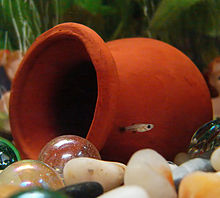
Live-bearing fish, often simply called livebearers, are fish that retain the eggs inside the body and give birth to live, free-swimming young. Among aquarium fish, livebearers are nearly all members of the Poeciliidae family and include guppies, mollies, sailfin mollies, platies and swordtails. The referring livebearers are particularly the members of the Poeciliinae subfamily which members are almost all live-bearing fishes.
The advantages of livebearing to the aquarist are that the newborn juvenile fish are larger than newly-hatched fry, have a lower chance of mortality and are easier to care for.
Although the whole family Poeciliidae is known as "livebearers", some species are egg-scattering with external fertilization. All African species are egg-layers, and all American species are live-bearers. So thus, the term "livebearer" is more applicable, particularly in the subfamily Poeciliinae (though there are still exceptions). Among the three subfamilies, Aplocheilichthyinae is restricted to Africa, Poeciliinae is primarily from the Americas (the only exception is the African Rhexipanchax), and Procatopodinae is mainly from Africa (the South American Fluviphylax and Pseudopoecilia are the only exceptions). This distribution suggests that the Poeciliidae predate the split between Africa and South America 100 million years ago and that live-bearing subsequently evolved in South America. Poeciliids colonized North America through the Antilles while they were connected 44 million years ago. Poeciliids then moved to Central America by the Aves land bridge on the Caribbean Plate. When South America connected to Central America three million years ago, some further dispersal southward occurred, but South American species did not move into Central America.
The original distribution of the family was the southeastern United States to the north of Río de la Plata, Argentina, and Africa, including Madagascar. However, due to the release of aquarium specimens and the widespread use of species of the genera Poecilia and Gambusia for mosquito control, poeciliids can today be found in all tropical and subtropical areas of the world. In addition, Poecilia and Gambusia specimens have been identified in hot springs pools as far north as Banff, Alberta.
They are highly-adaptable fishes, capable of living from freshwater to fully marine habitat. Though some are not tolerable, most of the species in the genus Poecilia can. They can even live in the polluted waterways, canals, ditches, streams, and rivers.
Common aquarium livebearers
editAs said earlier, the particular live-bearing species are in the Poeciliinae subfamily. Species of interest to aquarists are almost always members of the family Poeciliidae, more specifically, the subfamily Poeciliinae, such as guppies, mollies, sailfin mollies, platies, swordtails, and mosquitofish.
Live-bearing aquarium fish, often simply called livebearers, are fish that retain the eggs inside the body and give birth to live, free-swimming young. Because the newborn fish are large compared to the fry of oviparous fish, they are easier to feed than the fry of egg-laying species, such as characins and cichlids. This makes them much easier to raise, and for this reason, aquarists often recommend them for beginners to fish breeding. In addition, being much larger makes them far less vulnerable to predation, and with sufficient cover, they can sometimes mature in a community tank. They generally need a ratio of 1 male to 4 females to avoid and distribute the stress in mating and lessen the agression in males. The five most common livebearers are listed below:
| Guppies and mollies |
| Common name | Taxonomy | Picture | Size | Remarks | Temperature range | pH range |
|---|---|---|---|---|---|---|
| Guppy | Poecilia reticulata | 5 cm (2.0 in) | Many color and tail pattern varieties exist. | Tropical; 16°C - 32°C | 7.0 - 8.0 | |
| Molly | Poecilia sphenops | 8 cm (3.1 in) | Many color varieties exist | Tropical; 16°C - 32°C | 7.5 - 8.2 | |
| Sailfin molly (Sold under the name "molly") | Poecilia latipinna | 16 cm (6.3 in) | Many color varieties exist | Subtropical; 20°C - 28°C | ||
| Southern platyfish ("Platy") | Xiphophorus maculatus | 6.4 cm (2.5 in) | Many color varieties exist | Tropical; 16°C - 25°C | 7.0 - 8.0 | |
| Green swordtail ("Swordtail") | Xiphophorus hellerii | 12.8 cm (5.0 in) | Many color varieties exist | Tropical; 20°C - 32°C | 7.0 - 8.0 |
Ovoviviparous and viviparous fish compared
editMost of the Poeciliidae are ovoviviparous, that is, while the eggs are retained inside the body of the female for protection, the eggs are essentially independent of the mother and she does not provide them with any nutrients. In contrast, fish such as splitfins and halfbeaks are viviparous, with the eggs receiving food from the maternal blood supply through structures analogous to the placenta of placental mammals.
| Poeciliinae | |
|---|---|
| Green swordtail, Xiphophorus hellerii | |
| Scientific classification | |
| Domain: | Eukaryota |
| Kingdom: | Animalia |
| Phylum: | Chordata |
| Class: | Actinopterygii |
| Order: | Cyprinodontiformes |
| Superfamily: | Poecilioidea |
| Family: | Poeciliidae Garman, 1895 |
| Genera | |
|
Subfamily Poeciliinae | |
Making a Happy Livebearer aquarium
editThe species you want to keep always depend on how large your tank/container or aquarium is. But in this case, guppies are used in the activity. Needs:
- 20-liter tank/container or aquarium
- 10 guppies (use the ratio 1 male to 4 females, in this case, 2 males and 8 females)